Dutch Government Troop Transports and Emigrant Ships
These three famous ships were originally part of 414 standard ‘Victory’ (VC2-S-AP5) types of 7,630 grt and 117 Victory Attack Transports (AP and APA) types that were built by numerous American shipyards during World War II. This gave a total of 531 fast ships that were ideal to support the fast-moving American island troop advances in the Pacific towards Japan. Some 97 of the standard VC2-S-AP5 were completed as troopships before the war ended with a service speed of 17 knots or higher from steam turbine machinery. Extensive use of prefabrication was made with arc welding used instead of the traditional riveting by sub -contractors some distance away from where the final assembly of the hull took place on ‘green field’ shipbuilding sites. The hulls were specially strengthened for use in war zones.
Cranston Victory was launched on 5th May 1944 at the Portland yard of the Oregon Shipbuilding Company, and after fitting out was operated by the U. S. Maritime Commission for the South Atlantic Steamship Company of Savannah. She was purchased in February 1947 by the Dutch Government (Directorate-General of Shipping) for $1.005 million and renamed Zuiderkruis after the constellation of the Southern Cross of four bright stars. It is also known as Crux, a cross shaped asterism prominent in the Southern Hemisphere, and although the smallest of 88 constellations in the night sky, it is one of the best known and the most prominent seen in Australia and New Zealand.
Costa Rica Victory was launched on 17th June 1944 at the Richmond (California) yard of the Permanente Metals Company, and completed three months later for the U.S. Maritime Commission and operated by the American-Hawaiian Steamship Corporation of New York. She was purchased by the Dutch Government on 19th February 1947 for $1.005 million and renamed Groote Beer (Great Bear) after the constellation of Ursa Major of seven stars seen in the Northern Hemisphere. The constellation is well-known as the ‘Plough’ in the U.K. and as the ‘Big Dipper’ in the U.S.A. and Canada. Consequently, it is the best known constellation in the night sky, and is commonly drawn to represent the hindquarters and tail of a large bear. Six of the seven stars are of magnitude 2.0 or higher.
La Grande Victory was launched on 16th January 1945 at the Portland yard of the Oregon Shipbuilding Company for the U.S. Maritime Commission, and was operated by the Shephard Steamship Company of Boston. She was purchased in February 1947 by the Dutch Government (Directorate-General of Shipping) for $1.005 million and renamed Waterman, which is the constellation of Aquarius. This is one of the oldest recognised constellations along the zodiac of the sun’s apparent path, and was known to the Romans as the ‘water carrier’ or ‘waterman’. The star Beta Aquaril is of bright magnitude 2.9 and is the brightest star in this constellation.
Many more of these fast troopships found their way into the fleets of the emigrant shipping companies and governments of the United States, Canada, Greece, Australia and New Zealand. The troopships had austere dormitory accommodation down in the five holds of the ‘Victory’ types, and this was the case with Groote Beer, Waterman and Zuiderkruis between 1947 and 1951 when employed on long voyages to and from the Dutch East Indies and Dutch New Guinea. The trio were used from Holland to the Dutch East Indies to carry troops to the Dutch colony to restore the peace after the Japanese surrender when the Dutch archipelago was in turmoil. After the independence of Indonesia in 1948, all Dutch troops were repatriated, and then it was the turn of the Dutch civilians to be repatriated to Holland. This mission was completely and successfully finished in 1951.

CONVERSION TO EMIGRANT SHIPS
A major steelwork conversion was carried out in 1951 at the Amsterdam yard of the Nederland Dry Dock and Shipbuilding Company to convert the austere troopship accommodation of the Dutch Government trio for 1,500 to 1,600 troops into emigrant carriers carrying 830 passengers, expatriates, students and emigrants. The existing two superstructure decks were converted into continuous passenger decks extending to their sterns, together with the lifting of the navigating bridge to a position one deck higher after the insertion of a complete, new long ‘A’ Deck extending to a position vertically above the stern. Spacious sports and sunbathing open air spaces were situated aft on ‘A’ Deck. The complement of lifeboats for 830 people was updated to ten large boats on ‘A’ Deck and six large boats on ‘B’ Deck.
The Main Lounge forward on ‘A’ Deck had seating for well over one hundred people at the forward end of the deck, with an open entrance to a bar on the port side at the rear of the lounge, and an open entrance to the writing room on the starboard side at the rear of the lounge. A number of smaller internal lounges finished in blue decoration were built on ‘C’ and ‘D’ Decks between the passenger cabins, each seating around 30 to 40 people. Passengers paying cabin voyage fares of 610 guilders per adult, children up to 12 years at half price, and babies up to one year at 38 guilders, were accommodated in the superstructure on five decks as follows:-
‘A’ Deck – Main Lounge forward, Writing Room, Bar, Wireless Office, Doctor, Medical Waiting Room, Children’s Play Room, Open Air and Sheltered spaces aft for sports and games e.g. table tennis.
‘B’ Deck – Entrance Hall, Purser’s Office, Hairdressing Salon, Baby Washroom, Laundry and Ironing Room, cabins for 4, 6 or 8 passengers.
‘C’ Deck – Internal Lounges, cabins for 4, 6 or 8 passengers.
‘D’ Deck – Internal Lounges, cabins for 4, 6 or 8 passengers.
‘E’ Deck – Large forward rectangular Dining Room lit from above by strip lighting and by many portholes to starboard and port, with tables for eight, twelve or sixteen diners, Galley, Javanese steward cabins and crew cabins, plus cabins for 4, 6 or 8 passengers.
Four large dormitories housing a huge number of steel upper and lower bunk beds were arranged in groups in the three forward and two aft cargo holds, designated as ‘AA’, ‘BB’, ‘CC’ and ‘DD’ Decks for use by emigrants at cheaper passage fares of 570 guilders per adult, children up to 12 years at half price, and babies up to one year at 24 guilders.

The funnel colours were buff yellow with thin central red, white and blue bands of the Dutch national colours and a thin black top, and the hull colours were light grey. ‘A’ and ‘B’ Decks had raised metal stanchions so that canvas awnings could be erected on top to provide much needed shade for passengers on long six week voyages to Australia and New Zealand. The derricks on the fore mast and main mast were retained for cargo and baggage handling. The trio of Dutch emigrant carriers were registered at The Hague, the capital of Holland, and after conversion had the following specifications:-
Gross Tonnage – 9,177 to 9,191
Overall Length – 455.0 feet
Moulded Beam – 62.0 feet
Moulded Depth – 38.0 feet
Loaded Draft – 20.6 feet
Fo’c’stle length – 87.0 feet
Bale capacity – 24,295 m3
Main Machinery – Cross compound steam turbines with double reduction gearing developing 9,350 shp to a single propeller, 3 generators for electricity
Service Speed – 17 to 18 knots
Bunker capacity – 1,595 tons
Ballast water – 1,675 tons
Classification Society – American Bureau of Shipping
Bridge equipment – Radar, electric signalling device, gyro compass, direction finder
Deadweight tonnage – 4,130 tons

THE EMIGRANT VOYAGES FROM 1951 to 1963
The emigrant voyages of all three Dutch Government emigrant ships were mostly nine to ten day westbound voyages to ports in Canada and the U.S.A. particularly Halifax (NS), Quebec, Montreal and New York. Groot Beer especially made a very large number of these voyages and carried a vast number of passengers and emigrants starting new lives, and also carried numerous passengers eastbound returning to Holland. These North Atlantic voyages were interspersed with long six week voyages to the Australian and New Zealand ports of Sydney, Melbourne, Adelaide, Fremantle and Wellington. Several of these voyages stand out in the memories and written accounts of passengers and emigrants.
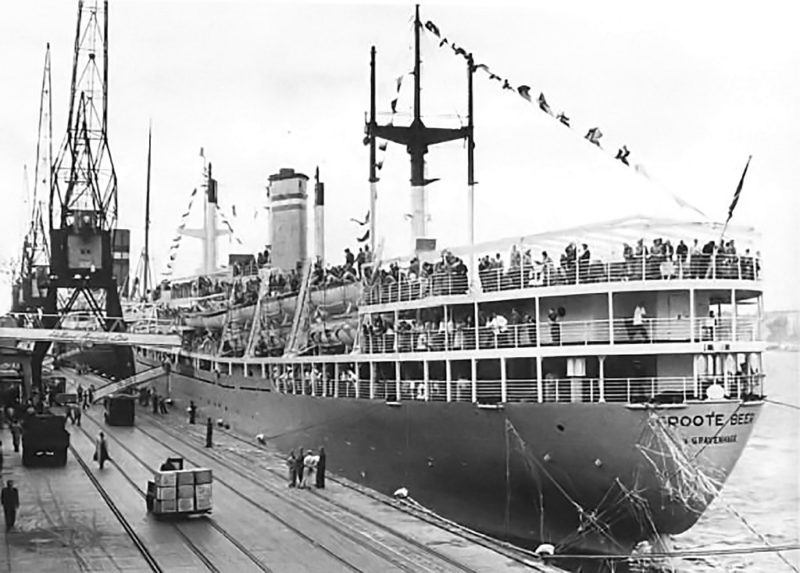
GROOT BEER
She was under the management of Holland America Line for Transatlantic voyages, and made three long voyages to Australian ports in 1951 before her conversion, with arrivals at Fremantle on 21st March 1951 and 22nd June 1951, and at Wellington on 19th September 1951. The latter voyage disembarked 450 passengers in New Zealand with another 400 passengers bound for Australian ports. The reconstruction to an emigrant carrier began in November 1951 and she sailed from Rotterdam on a ten day voyage to the disembarkation Pier 21 at Halifax (NS) in April 1952. On 20th November 1955 she arrived at Fremantle from Rotterdam with another 850 passengers and moved on to other Australian ports to disembark the full complement. On 25th October 1958, she sailed from Rotterdam on a six week voyage to the Australian ports of Fremantle, Adelaide, Melbourne, Sydney (NSW) and Brisbane. In January 1959 she sailed from Rotterdam to Australian ports with more emigrants, and also arrived at Fremantle on 17th November 1961 and moved on to other Australian ports from Rotterdam to disembark the full complement of passengers.
Groote Beer averaged thirteen voyages per year to Canada and the U.S.A. during the years 1951 to 1960, and was a very regular visitor to the main Pier 21 disembarkation point at Halifax (NS), with examples of her voyages on the North Atlantic of an arrival at Halifax (NS) on 21st October 1952 and she moved on to New York from Rotterdam, a departure from Rotterdam on 11th June 1955 for Halifax (NS) and New York, and she returned to Rotterdam at the end of that month, a departure from Rotterdam on 16th January 1957 for Halifax (NS) and New York, arriving nine days later, a departure from Rotterdam on 1st August 1957 for Quebec and Montreal, taking twelve days to Montreal, an arrival at Quebec on 7th August 1958 and she moved on to Montreal from Rotterdam, and a departure on 6th August 1959 from Rotterdam for Quebec and Montreal.
WATERMAN
She was under the management of Rotterdam Lloyd of Rotterdam, with Holland America Line acting as agents for her Transatlantic voyages. She began her emigrant carrying career in November 1951 with a six week voyage to Fremantle, Adelaide, Melbourne, Sydney (NSW) and Brisbane. She sailed from the Rotterdam Lloyd Pier at her home port of Rotterdam on 13th March 1957 with 312 Hungarian emigrants and refugees bound for Canada. On the next morning in poor visibility, she was rammed on the stern by the Italian cargo ship Merit shortly after the emigrants had finished their breakfast in the first sitting in the Dining Room, with the passengers taking the second sitting. This was much more to do with a different menu for the Eastern European and for the Dutch passengers, rather than strict separation. Suddenly at 0820 hours a loud bang was heard at the stern of the ship with the noise of falling furniture and broken crockery and dishes, and a distress call was sent out immediately by her Master as she was carrying a large number of people.
Everyone was then ordered to proceed to the lifeboat stations with their life jackets on as a precaution, but a further order from the Navigating Bridge quickly followed for everyone to return the life jackets and proceed to their cabins and continue with their routine or business as the ship was not in any danger of sinking. If embarkation into the lifeboats had taken place, the men were directed to pull the oars while the women and children lay or were seated on the bottom of the boat. A long horizontal hole had been gouged on her port quarter but was high enough above the waterline to not present any danger, and it was quickly stuffed with mattresses and timber from the nearby carpenter’s shop. She then made at reduced speed for the port of Brest with a German liner following her as a precaution, where all passengers and emigrants were disembarked and transferred to the already waiting sister Zuiderkruis and directed to their same cabin numbers, as all of this trio were identical in cabin and public room layout. The agents and crew that were regularly onboard all three members of the trio could not distinguish one ship from another. A choppy North Atlantic crossing was then made to Halifax (NS), where everyone disembarked.
The same absence of passengers and emigrants from the Dining Room was noted by the crew shortly after Waterman had sailed from Rotterdam for Halifax (NS) and New York on 25th April 1955, and again in August 1955 with the ship pitching and rolling badly for several days in the voyage that only lasted nine and a half days. Calmer seas were encountered on a voyage to Wellington via the Panama Canal, having sailed from Amsterdam on 1st December 1960 and arrived at Wellington on 9th January 1961, much to the relief of the passengers and emigrants.

Waterman made the following interspersed emigrant voyages on the North Atlantic and to the Antipodes, with arrivals in June 1952 and June 1953 at Halifax (NS) from Rotterdam, an arrival at Melbourne on 12th February 1955 from Rotterdam after a six week voyage, a departure on 25th April 1955 from Rotterdam to New York, an arrival at Australian ports in July 1957 from Rotterdam after a six week voyage and she moved on to other Australian ports, an arrival at Halifax (NS) in April 1958 from Rotterdam after a nine day voyage, an arrival at Australian ports in June 1958 from Rotterdam after a six week voyage, an arrival at New York on 24th September 1958 from Rotterdam after a ten day voyage, an arrival at New York on 25th May 1959 from Rotterdam after a ten day voyage, an arrival at Quebec in July 1959 from Rotterdam after a twelve day voyage, and an arrival at Halifax (NS) on 4th July 1960 with some passengers disembarking at the main Pier 21 from Rotterdam, with the remainder sailing on to Quebec, and an arrival at Melbourne from Rotterdam in July 1962 after a six week voyage.
Waterman sailed from Rotterdam on 26th September 1962 on one of her last emigrant voyages to Dutch New Guinea, with the voyage taking her through the Mediterranean to Port Said and the Suez Canal with a call at Djibouti in the French colony on the southern Red Sea, and she then bunkered at the Shell depot on the island of Pulau Bukom off Singapore before arriving at Biak Island on the West Irian part of New Guinea held by Indonesia at that time. On her return to Rotterdam, she then made her final voyage in January 1963 to several Australian and New Zealand ports. All three ships of the trio were then sold by the Dutch Government in 1963.
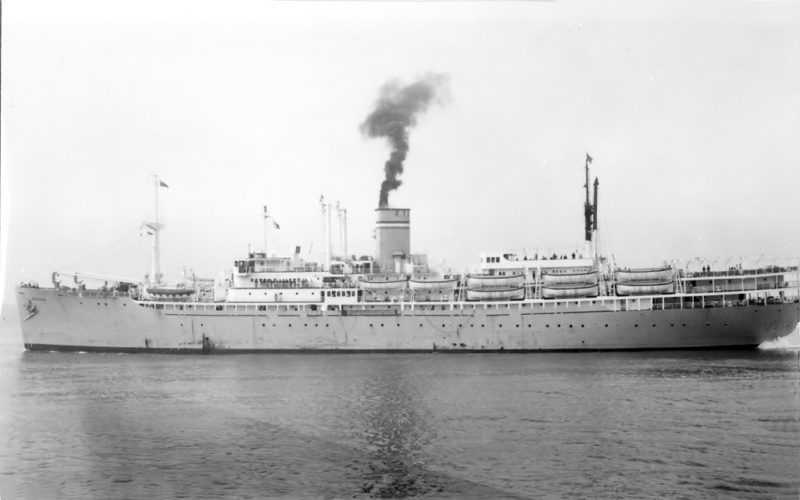
ZUIDERKRUIS
She was under the management of Nederland Line of Amsterdam for the voyages to Australia and New Zealand, with Holland America Line acting as agents for the North Atlantic voyages. She began her emigrant voyages in June 1951 with a sailing from Rotterdam to New York in ten days, with her next voyage being to Quebec and Montreal in twelve days, followed by a voyage with a full complement of 830 migrants to Auckland and Wellington in New Zealand in August 1951 taking six weeks.
Zuiderkruis sailed from Amsterdam on 26th September 1956 on the long six week voyage for Wellington, but ran very short of water during the last four or five days due to the fresh water tanks having run dry. She had called at Willemstad (Curacao) for bunkers and then transitted the Panama Canal with another call at Papeete on Tahiti. The sittings for breakfast were remarkably empty on the second, third and fourth days of the voyage before they cleared the Bay of Biscay due to almost everyone being seasick and they stayed in their cabins. A calmer route well to the south of Madeira but north of the Canary Islands was then followed to ease the stomachs of the passengers. Examples of her emigrant voyages on the North Atlantic were departures from Rotterdam to Halifax (NS) in February and June 1952, a departure from Rotterdam on 19th September 1955 for Quebec and Montreal, a departure from Rotterdam on 14th June 1956 for New York, a departure on 10th April 1957 from Rotterdam for Halifax (NS), and an arrival at Melbourne on 11th September 1961 from Rotterdam after a six week voyage.
In 1960, the Dutch KLM airline became the carrier of choice for most emigrants, and a year later the Dutch Government formed their own shipping company of Trans-Ocean Shipping Co. N.V. of The Hague, and all of the trio were registered under this company, although each ship continued to be managed by the same Dutch shipping companies as before. In the same year, the facilities of the trio were greatly improved with the addition of a cinema and entertainment venue ‘topsides to make their accommodation and facilities truly Tourist Class rather than Emigrant Class, and attract a better class of passenger trade, as the migrant trade was now declining.
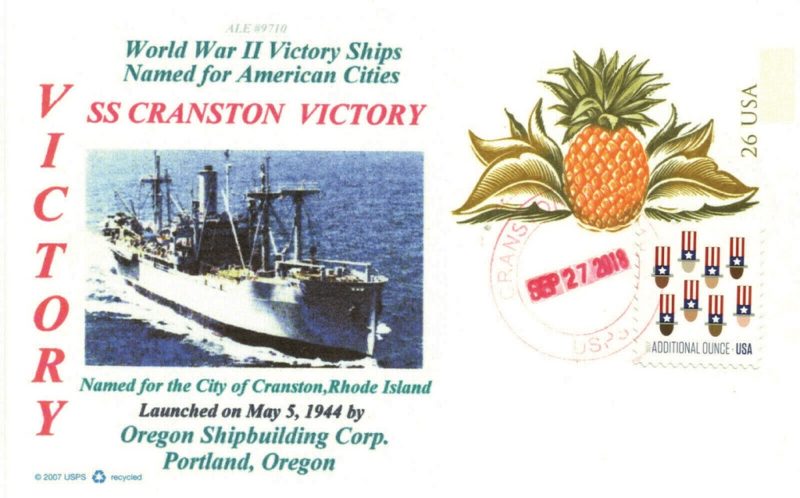
The dormitories were reduced in size and additional two berth cabins were added plus a swimming pool. Groote Beer was chartered for the Commonwealth Games at Perth in 1962, and lay at her berth in Fremantle with the very famous twin funnelled liner Johan van Oldenbarnevelt of 19,787 grt at her stern. She had been built in 1930 at Amsterdam by the Nederland Shipbuilding Company, and was also in use as an accommodation ship on charter from Nederland Line.
In October 1963, Zuiderkruis was handed over to the Royal Netherlands Navy for use as an accommodation and store ship. She was berthed at the main naval base of Den Helder in the north of Holland and was given the pennant number of A853. She was finally taken out of commission and sold in October 1969 to Spanish shipbreakers at Bilbao, where she arrived under tow on 27th November 1969.
Waterman and Groote Beer were both sold in 1963 to John Spyridon Latsis of Greece and were renamed Margareta and Marianna IV respectively for cruising in the Mediterranean, and for the seasonal pilgrim trade from Mediterranean countries to Jeddah. At Jeddah, pilgrims could stay at the hotel ships of Henrietta Latsi and Marianna Latsi, the former graceful P. & O. liners Strathmore and Stratheden, built in 1935 at Barrow by Vickers -Armstrong Ltd.
In May of 1968, the former Waterman headed for Tokyo to undertake two cruises, the first to Los Angeles and Honolulu, and the second to San Francisco and Honolulu. She was laid up in Japan at the end of the second cruise, but sadly never sailed again, being towed to shipbreakers at Onomachi in Japan in 1970.
The former Groote Beer was chartered by the Netherlands Government for three months from June to September 1964 to operate the ‘Atlantic Educational Program Foundation’ of four round voyages from Rotterdam to New York.
She was renamed Groote Beer once again but remained under the Greek flag with Holland America Line as her agents, but reverted to Marianna IV each winter. In the summer of 1965, she fulfilled a student exchange program under charter to Holland America Line, but the similar program for 1966 was cancelled.
Groote Beer sailed from Southampton on 12th July 1966 but was in collision with the sand dredger Pen Avon off the Isle of Wight while sailing to New York. The voyage was cancelled and she returned to Southampton, where basic repairs were carried out, and she was then laid up at Eleusis Bay at Piraeus unrepaired. She was renamed Marianna IV again in 1969 but she was sold out of lay up in 1971 for breaking up locally at Eleusis Bay.
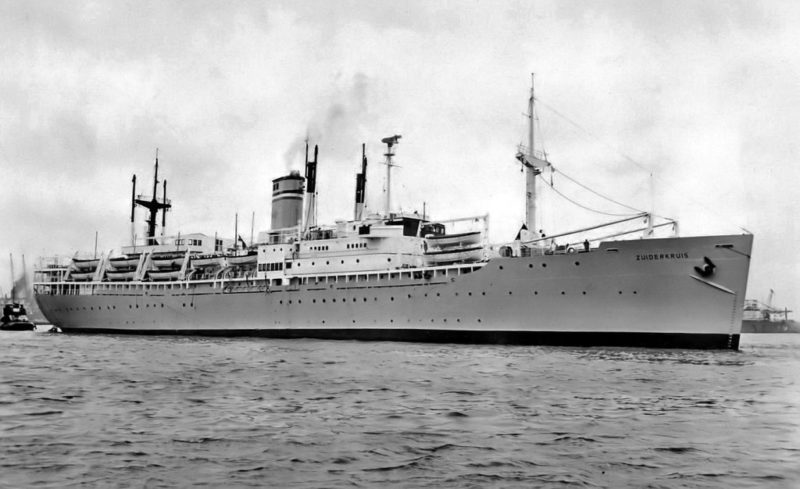
SUMMARY
These three memorable Dutch troopships and emigrant carriers were celebrated by the issue of a large number of the ‘Emigrant Series’ of ceramic wall plaques, measuring six inches square, in a series of twelve plaques showing famous Dutch liners, particularly those of Holland America Line, as well as three plaques for Groote Beer (above), Waterman and Zuiderkruis, that were produced and marketed in Holland in 1978 by Vanderheide Publishing, and which were available for sale to collectors for the next two decades. These ship plaques were by far the most popular out of a commercial list of 60 historical plaques of many themes, and included the very famous Holland America Line liners Nieuw Amsterdam, Rotterdam, Statendam, Westerdam, Noordam, Ryndam and Maasdam.
The very long links of Dutch people with the Boers of South Africa saw this trio of Dutch emigrant ships also make many voyages to South Africa. Waterman arrived several times at Cape Town between 1951 and 1955 with Dutch immigrants to South Africa. The span of the emigrant voyages of Groote Beer, Waterman and Zuiderkruis took place during the very short space of twelve years from 1951 to 1963.
This mass exodus of Dutch people seeking a new life in North America, Australia, New Zealand and South Africa was a direct consequence of the destruction of the infrastructure of Holland during World War II and the fragile state of its economy in the late 1940s and 1950s.
A report was published by the Dutch Government Publishing Office in 1954 on the characteristics of Dutch emigrants who wished to emigrate to Australia, New Zealand, Canada, the U.S.A., and South Africa. Thousands of single men and families were interviewed and many different reasons were mentioned but the economic factor, although present in most cases, was not the most significant one.
The presence of relatives in the receiving country was one of the most important factors, as was the aspiration towards self – employment in the receiving country rather than working for other people at substandard wages, working conditions and terms of employment without security of employment and adequate pensions.
Conditions for the emigrants living in cramped dormitories in the holds and 4, 6 and 8 berth cabins in the superstructure on long six week voyages to Australian and New Zealand ports did not begin to improve until the alterations were made in 1961, including much reduced dormitories, fewer passengers per cabin, and a large cinema and entertainment venue ‘topsides with better sports facilities. The funnel colours during the Trans-Ocean Steamship Company were orange with the three thin central bands of red, white and blue of the Dutch national flag from 1961 to 1963.
This company later became a subsidiary of Holland America Line and was used for student travel and for cruising. The trio were often dressed overall with flags stretching from the jack on the fo’c’stle to the fore mast and to the bridge, and also around the main mast to the stern on departures and arrivals.
The equivalent to this trio in the British fleet of Government owned emigrant carriers were the well-known Ministry of Transport ships New Australia, Captain Cook and Captain Hobson. New Australia was the former New York to Bermuda liner Monarch of Bermuda owned by Furness, Withy Shipping Ltd. She was destroyed by fire on 24th March 1947 while undergoing renovation work on the Tyne at the Walker Naval Yard to return her to passenger work from a troopship. She was purchased by the Ministry of Transport and rebuilt by Thorneycroft at Southampton as an Australian emigrant carrier with 980 berths. She made her first emigrant voyage from Southampton on 15th August 1950 and continued in this employment until sold in January 1958. Captain Cook of 13,876 grt was built in 1925 by the Fairfield yard on the Clyde as Letitia for Donaldson Line became an emigrant carrier between 1951 and 1960 with 1,070 berths. Captain Hobson of 9,306 grt was built in 1920 as Amarapoora by Denny on the Clyde for Henderson Line and was converted into an emigrant carrier with 585 berths.
A likeness to the profile of the trio of Groote Beer, Waterman and Zuiderkruis, named after constellations, and all of the other many types of emigrant ships with very cramped accommodation, will never be seen again on the seven seas.

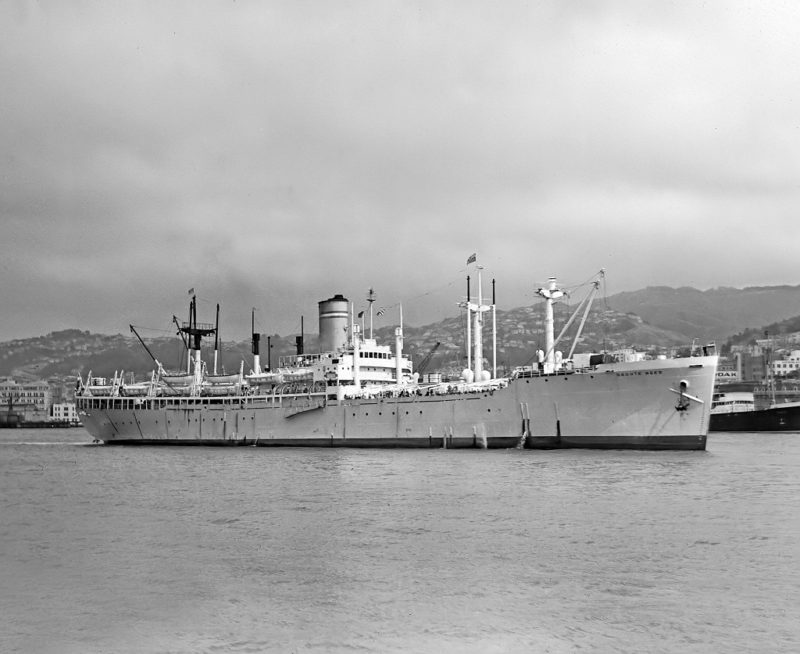
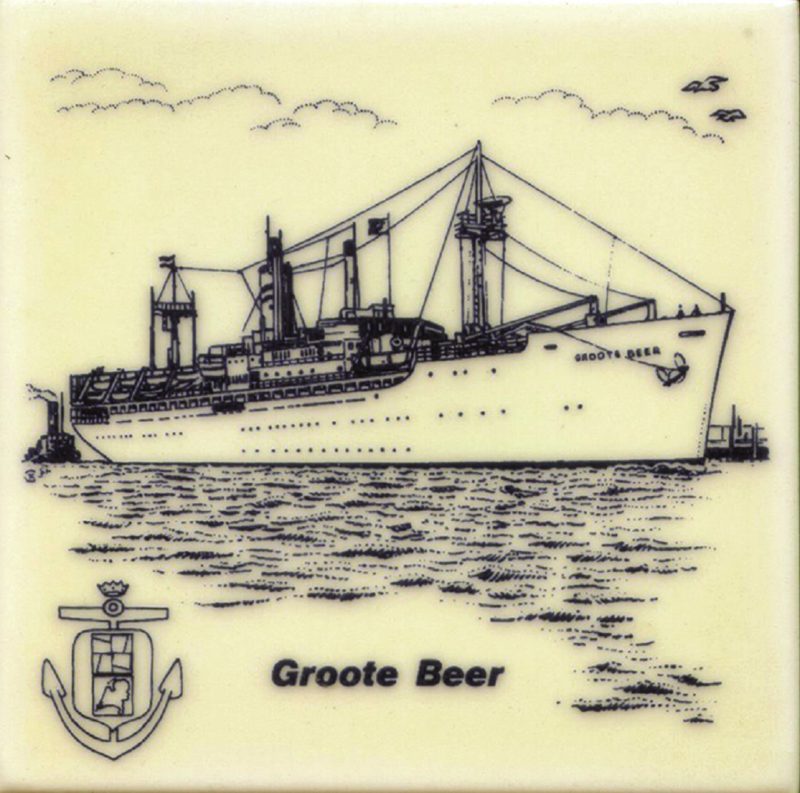




Comments
Sorry, comments are closed for this item